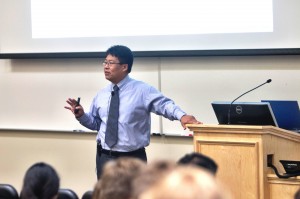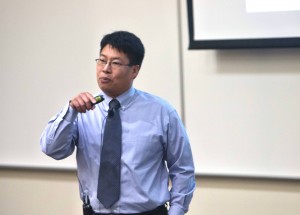New research developments regarding liver cells may offer a new possibility to cure cancer.
Dr. Chin-Yo Lin, PhD, gave a seminar in the Life Sciences Building last week discussing liver X receptors, titled “X Marks the Spot.”
Lin, from University of Houston, is also a graduate of BYU and has previously taught at the university. He and his team have been researching liver X receptors for a while and said they are very excited about the possibilities open before them.
Liver X receptors belong to a family of genes called nuclear receptors, according to Lin. Their functions involve regulating metabolism and the transportation of cholesterol. These receptors are also very good druggable targets. Lin said the hope is that they will be able to slow down and/or block the production of cancer cell growth by activating these receptors.
“This particular family of genes is of interest because they regulate the pain expression in response to chemical signals that are found in themselves as well as in our bodies,” Lin said. “And why there’s such interest in this family of genes is that they make or break nerve targets.”

Lin said research began when they collaborated with another research group in Sweden, who found liver X receptor ligands can block the production of breast cancer cells. Lin said he and his team decided to move on to something a little more challenging while their Swedish co-workers stayed on the job of breast cancer.
“LXR agonists can decrease the stability of the growth factor receptor, which is also a drug target in this and other cancers as well,” Lin said.
They chose to focus their research on pancreatic cancer. Lin said pancreatic cancer is one of the more difficult cancers to treat and that the death rate for this type of cancer is on the rise. The number of deaths per year is an estimated 37,300 per year according to the National Cancer Institute, just behind the death number of breast cancer, as breast cancer claims about 40,000 lives per year.
One challenging aspect of pancreatic cancer is that doctors do not know how to detect it until it is too late for the patient. The cancer progresses rapidly through the tissues in the pancreas, according to the Mayo Clinic.
From some of his most recent research, Lin said it looks like LXR agonists are able to decrease the stability of the growth factor receptor. This receptor is a drug target in pancreatic and also in other cancers.

“To be honest, we’re still staring at these lists of genes, we’re not done staring yet,” Lin said, “If we combine the drugs with EGFR inhibitors we might get an additive effect.”
Lin said they still have some work to do before they release it for clinical trials.
Lin also talked about their research and experiments done on animals.
“We’ve cured cell-lines of cancer many times over,” Lin said.
He then recalled President Richard Nixon declaring war on cancer nearly 50 years ago.
“He said, ‘After 40 years we do a very good job of curing mice of cancer.’ That’s also a reminder that, yes, mouse model is better than cell-lines, but we’ve still got a ways to go,” Lin said.




